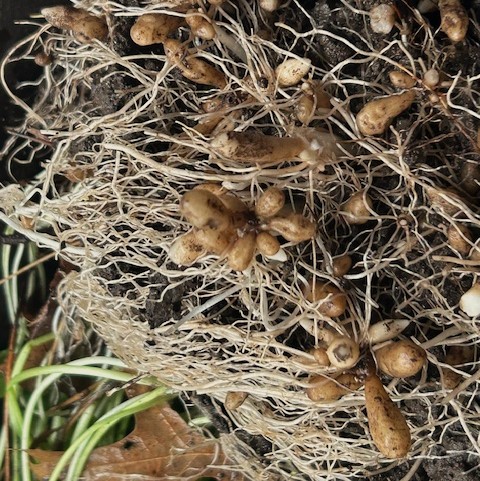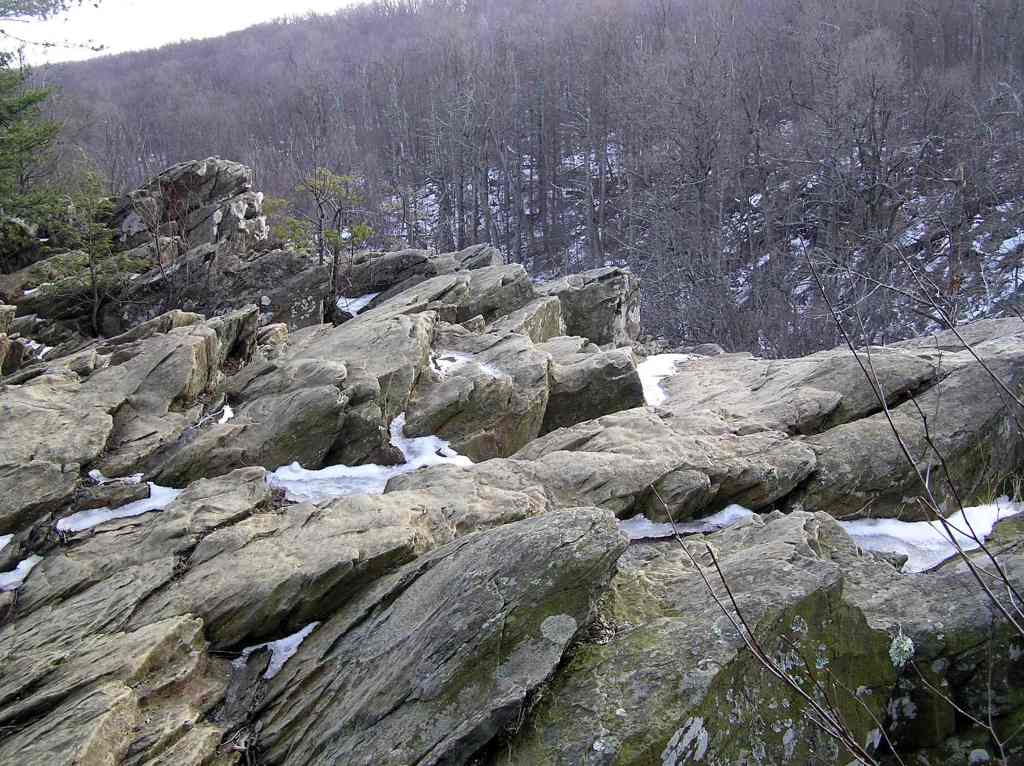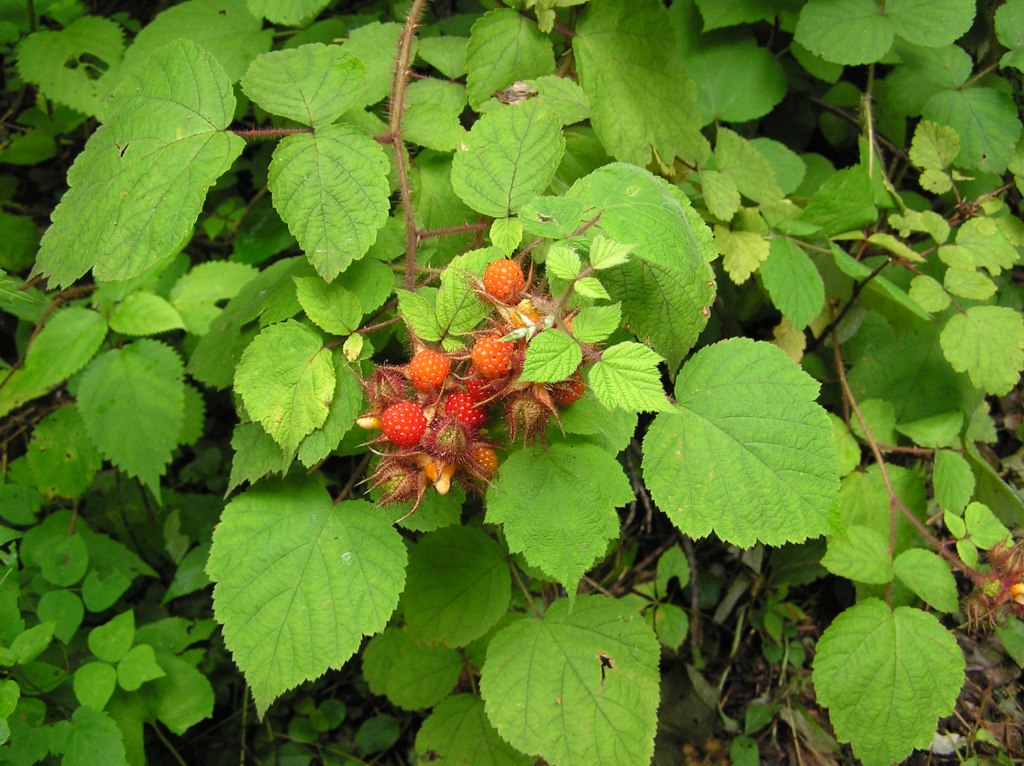
Common Name: Timber Rattlesnake, Canebrake Rattlesnake, Banded Rattlesnake, Black Rattlesnake, Eastern Rattlesnake – The name ‘timber’ describes the snake’s preferred habitat of rocky hills and forest uplands. The species is one of several that employ the rattle’s auditory warning.
Scientific Name: Crotalus horridus – A crotalum is one of a pair of small cymbals that were used in antiquity to make a clicking noise; the castanet is a vestige. The generic name derived from it refers to the clicking noise made by the segments of the rattle. The species name horridus, in spite of its seeming etymological association with ‘horrid,’ has nothing to do with either the human perception of the snake or its venom. Horridus is Latin for ‘rough’ or ‘bristly’ and refers to the rough appearance of the scales due having a raised keel-like edge in marked contrast to the smooth skin of many snakes. [1]
As the only large and relatively common poisonous snake in the Appalachian Mountains, the timber rattlesnake evokes both existential fear and an abiding respect from all who cross its path. There is certainly a justification for these perceptions: its size ranges from 3 to 5 feet (the record is 6 feet); its venom is exuded in copious quantities through long and penetrating fangs; its potentially lethal strike is launched at lightning speed that is almost too fast for the eye and certainly too fast for the reflexes; and its bite can be deadly to humans if untreated. [2] However, the incidence of timber rattlesnake strikes on humans is vanishingly small, resulting in one or two fatalities per decade nationwide. The most common cause is handling snakes as a part of a religious ceremony [3]. The reason for the disparity between the potential for injury and the incidence of injury is that the timber rattlesnake is docile and will only strike if repeatedly provoked and threatened.
Ophidiophobia, the fear of snakes, is the most common type of herpetophobia, which applies to all reptiles. This fear is innate and almost certainly the result of evolution which may extend back in time to the earliest mammals, huddling in dark recesses to escape predatory dinosaurs. [4] Fear of snakes was reinforced in primates that evolved as tree dwellers where constricting snakes followed them in search of a meal. Recent research on macaque monkeys in Japan revealed that a region of the brain that is unique to primates called the pulvinar was especially sensitive to sighting snakes. Furthermore, monkeys that were raised in captivity without prior exposure to snakes displayed fear on first encounter. [5] Culturally, the serpent became a symbol of pernicious influence, chosen by the writer of Genesis as the tempter of Eve. Consumption of the fruit of the tree of knowledge led to expulsion from the Garden of Eden and God’s proclamation that the serpent would always crawl on its belly and eat dust. [6] Fear of snakes is embedded in the brain’s amygdala along with the fight or flight response that triggers panic action. However, cognition based on information stored in memory can override fear, a point enunciated by Roosevelt’s in his first inaugural address: “The only thing we have to fear is fear itself”.

The timber rattlesnake is a consummate predator, well endowed with both the sensory tools and the physical agility to sustain its wholly carnivorous nutritional needs. As a pit viper, it has the namesake opening, or pit, just below the feliform vertical eye slit; the pit is the primary means of detecting prey. The sensory organ in the pit is a heat receptor, capable of detecting a 1°C difference at a range of about one foot. This is both necessary and sufficient to detect and engage its warm-blooded prey during the preferred nocturnal forays when the cooler air accentuates the temperature differential. The strike is executed by the reflex-quick straightening of the lateral muscles to transition from either an S-shaped or coiled stance to full length extension; the fanged triangular head is projected about half of its body length. In other words, a 4-foot snake can strike at 2 feet. Contrary to popular folklore, the coiled position is not a strike prerequisite, though the snake will typically assume this posture in anticipation of a mammal’s traverse. Following the consummation of a successful strike, the olfactory sensors on the forked tongue are used to locate the head from the emanations of the victim’s mouth odors to initiate cephalic ingestion, a preference based on the anatomical connections of any attached appendages. Digestion is almost total; the gastric fluids in the rattlesnake dissolve everything including the bones, adding about 40 percent of the snake’s body weight annually. The prey consists almost entirely of small mammals. A 1939 survey in George Washington National Forest, which included the capture and evisceration of 141 timber rattlesnakes, found that the stomach content was 38% mice, 25% squirrels and chipmunks, 18% rabbits, 13% birds, and 5% shrews; one had eaten a bat. [7]
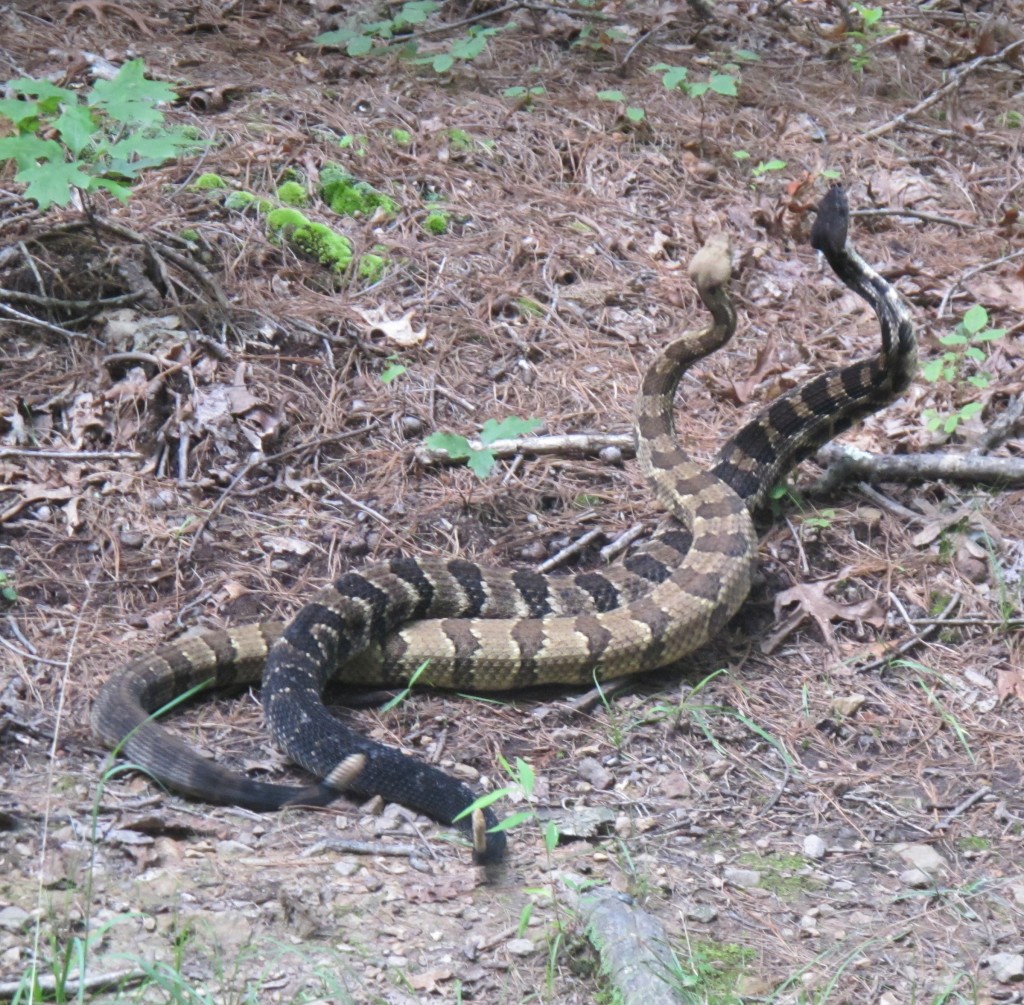
Sex is vitally important for nearly every living thing on planet Earth. While perhaps historically overemphasized and of late deemphasized among humans, it is the essence of evolution. The random genetic mixing that is the result of the male-female “interaction” to form the gamete is how speciation (including our own) occurred. This is equally true for timber rattlesnakes, who take sex pretty seriously. While many snakes spend the cold winter months in a communal burrow called a hibernaculum, they range separately in search of prey for the remainder of the year. About every second year, females over the age of five years will release pheromones in the spring or early summer as they ply the leaf litter pathways of their home turf. The scent is strong enough to attract any and all males that happen by. The stage is then set for one of the most intriguing contests for the right to breed among all animals. Lacking arms, legs, and claws with only venomous fangs for teeth, what amounts to the timber rattlesnake version of an arm-wrestling contest ensues. Rising upward in intertwined arabesque coils, they try to push each other over. The prize goes to the one with the most stamina as the loser retreats dejected from the field. On first encountering the snakes depicted in the photograph, I was convinced that it was a male-female pre-coital ritual until learning of its even more surprising purpose from an expert. [8] Following insemination with one of the successful male’s two copulatory organs called hemipenes, the female gives birth to about a dozen young who are immediately on their own to face the world armed only with venom and slithering stealth. Most will not survive.
The signature rattle is a curiosity in its constitution and a conundrum from the standpoint of how it may have evolved; rattlesnakes are found only in the Western Hemisphere. The rattle starts as a bell-shaped horny protuberance called a button at the end of the tail. Every time the snake molts, which ranges from one to five times a year according to age and growth rate, the caudal end remains attached to form a segment of the rattle; the rattle grows in length by one segment for each molt. While it would theoretically be possible to count the number of times that the snake had shed its skin by counting the segments that constitute the rattle and thereby estimate the snake’s age, in actual practice this is fallacious. The rattle is loosely attached at each of the segments so that the assembly is subject to periodic breakage; it is not unusual to find a detached rattle segment on the trail. The conundrum associated with the rattle is that the rattlesnake employs both aposematism and crypsis simultaneously. The purpose of the rattle is ostensibly to ward off an attack by a potential predator, an aposematic behavior. However, their primary predators – which include hawks, owls, coyotes and foxes – are apparently not put off by the warning of the rattle. King snakes, the preeminent rattlesnake predators, are immune to the toxins of the rattlesnake. The defensive behavior of rattlesnakes in the presence of a king snake does not involve the rattle in any way; the midsection is arched with the extremities held to the ground in an attempt to club the attacker. Experiments have revealed that the smell of the king snake triggers this response. [9]
Charles Darwin was also perplexed by the peculiar rattle of the American snakes. He wrote that “Having said thus much about snakes, I am tempted to add a few remarks on the means by which the rattle of the rattle-snake (sic) was probably developed. Various animals, including some lizards, either curl or vibrate their tails when excited. This is the case with many kinds of snakes. Now if we suppose that the end of the tail of some ancient American species was enlarged, and was covered by a single large scale, this could hardly have been cast off at the successive molts. In this case it would have been permanently retained, and at each period of growth, as the snake grew larger, a new scale, larger than the last, would have been formed above it, and would likewise have been retained. The foundation for the development of a rattle would thus have been laid; and it would have been habitually used, if the species, like so many others, vibrated its tail whenever it was irritated. That the rattle has since been specially developed to serve as an efficient sound-producing instrument, there can hardly be a doubt; for even the vertebrae included within the extremity of the tail have been altered in shape and cohere. But there is no greater improbability in various structures, such as the rattle of the rattle-snake.” [10] The improbable evolution of the rattle had to have a provenance that was unique to the Americas; there are no rattle snakes anywhere else. There must therefore have been a predatory threat to the snakes that created the evolutionary rattle warning behavior. It was not human predation, as the land bridge of Beringia was not traversed to bring them from Eurasia until about 10,000 years ago. The only reasonable explanation must be that there was a snake predator among the extinct megafauna of the pre-human Tertiary Period and that the rattle developed as an effective tool to ward off that predator, presumably as an indication that the poisonous venom was, while perhaps not deadly, certainly unpleasant.
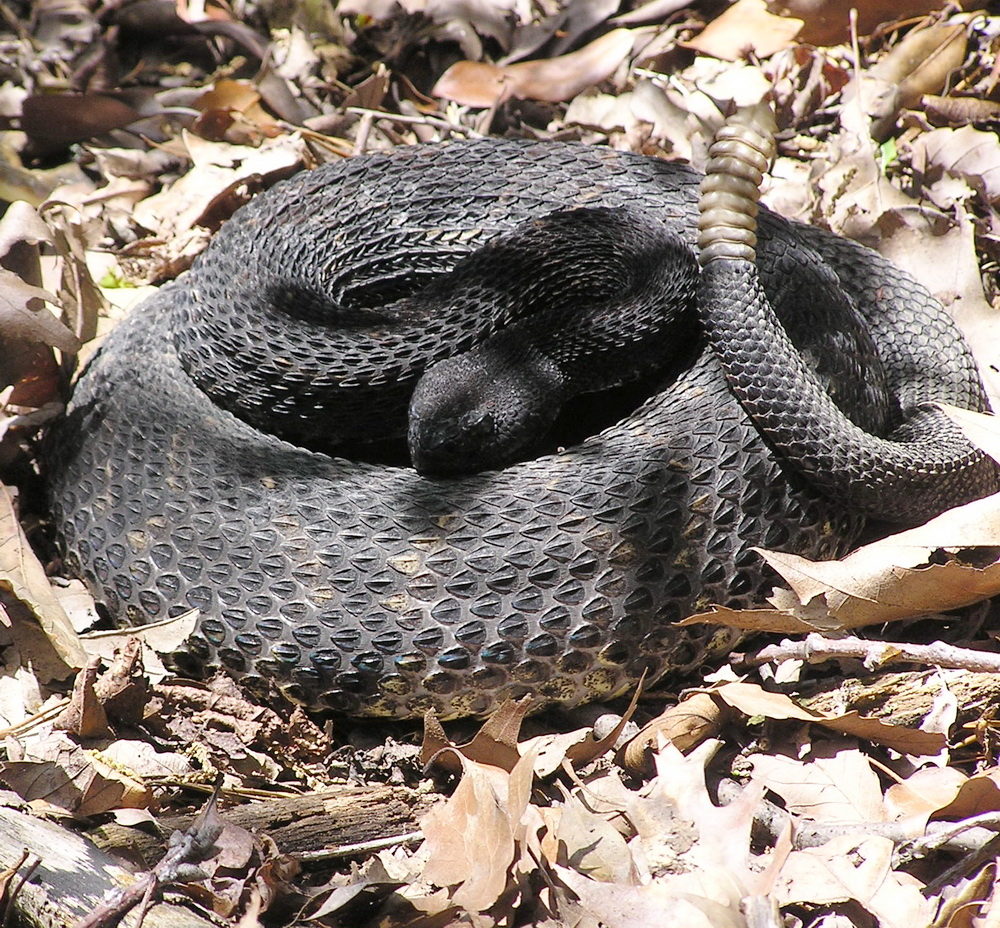
Timber rattlesnakes, for the most part, are colored with earth tone banded markings to blend with the browns and blacks of the forest; this is the camouflage of crypsis which can be employed to deceive prey but is equally useful as concealment from predators. However, it should be noted that there are at least two different cryptic color variants: the first is the canebrake rattlesnake, which was once considered a separate species, – it is more brightly colored to match its cane field habitat; the second is a much darker, predominantly black variant which is an adaptation to promote nocturnal hunting. The stealth of coloration is enhanced by the snake’s keeled scales – each having a central ridge to interrupt the otherwise scintillating sheen of reflectance as is the case with snakes with smooth scales without keels (the etymology of the species name horridus). The overall effect is that the snake is well concealed against its prey, but also against its predators. The fundamental question remains―why did the rattle evolve?
The venom of the timber rattlesnake poses a different evolutionary question that has resulted in some hypotheses as to its origins. Darwin offered “It is admitted that the rattlesnake has a poison fang for its own defense, and for the destruction of its prey” but offered no specifics as to its likely evolutionary origin. [11] Current thinking is that snakes evolved as large tree dwelling constrictors in the Miocene Epoch some 30 million years ago. When the climate changed so as to promote the grassy savannahs, the snakes became smaller and ground dwelling; some evolved a venomous chemistry for their saliva that promoted hunting and therefore their fitness to survive. Snake venom evolved as a complex chemistry of protein synthesis; depending on the species of snake, it may have a predominant neurological effect or a predominant vascular effect. Viper venom is of the latter category; its most obvious and potentially fatal symptom is slowing of blood circulation due to coagulation. From the standpoint of its intended small mammal prey, the venom achieves its objective of immobilization attendant to consumption. While the venom can be and to some extent is used to attack predators, it is not very effective. The king snake is immune to rattlesnake venom and other predators are either unaffected or able to avoid its application. One firsthand account reports that a wild turkey held down a timber rattlesnake with both feet that was “repeatedly striking at the bird’s long, armored legs and folded-in wings, but to no avail.” The turkey eventually killed the snake by cutting it through at the neck and then ate it. [12] Humans are another matter.
In any given year, approximately 45,000 people are reported to have been bitten by snakes in the United States; 6,000 of these are from venomous snakes and less than 10 results in fatalities – due almost entirely to the Eastern and Western variants of the Diamondback Rattlesnake. A larger number of domesticated animals are also bitten, though the numbers are of questionable merit as reporting is arbitrary and not required by law. The symptoms for snakebite vary according to the size of the snake and the amount of envenomation; about one fifth of poisonous snakebites are inflicted without the transfer of venom. This may be due to a dearth of venom after a recent kill or due to an intentional forbearance in order to preserve the venom for a future kill. The immediate symptoms of envenomation by a rattlesnake include intense pain at the point of penetration, edema and hemorrhaging. As the venom spreads through the body in the first few hours, the swelling and discoloration become more pronounced and systematic cardiovascular distress causes weakness, nausea and a diminution of the pulse to near imperceptibility. In the worst cases, a comatose state and death can result. In the twelve-to-twenty-four-hour period that follows, the affected limb suppurates and swells enormously, a condition that can also lead to cardiac arrest. In most cases, the symptoms abruptly cease after about three days as the body neutralizes the toxins. [13]
What to do in the case of a poisonous snakebite is and always has been a matter of some considerable conjecture. Traditionally (the cowboy hero western paradigm), a tourniquet is established between the bite and the heart to arrest the flow of blood-borne toxin, the area of fang penetration is cut open to afford better access, and an oral suction is established to extract the venom. Snakebite kits were (and probably still are) sold that have a razor blade and a suction cup to carry out this procedure with some efficacy. According to current thinking, the cut and suck method does not work very well, though human trial data is probably nonexistent. But the logic against the cut and suck method is compelling. Applying a tourniquet concentrates the venom to a smaller area, where the damage will be more profound. It is actually better to allow the body to dilute it the venom to diminish its effects. The location of the penetration is not necessarily where the venom is concentrated, as the snake’s fangs are long and curved; cutting will likely only result in a greater potential for infection. Suction is not a good method to remove the viscous venom, as it will have immediately permeated the tissue to the extent that it cannot be extracted with a vacuum pressure. The generally accepted procedure at present tends to a more plausible and less radical approach. After getting the victim clear of the immediate vicinity of the snake, the bite area should be cleaned with antiseptic wipes (if available), any jewelry or tight-fitting clothing should be removed to allow for swelling and the victim should then immediately be transported to a medical facility for the administration antivenom, which is now widely available. In the event that the snake bite has occurred in a remote area, the victim should be transported, either by being carried if possible or by slowly walking if not to the closest point of egress where medical attention can be obtained. [14] However, the only certain way to ensure survival from the bite of a timber rattlesnake is to not get bitten in the first place; if you see a timber rattlesnake on the trail, give it wide berth.
References:
1. Simpson, D. Cassell’s Latin Dictionary, Wiley Publishing, New York, 1968, pp 159,279.
2. Behler, J. and King, F. National Audubon Society Field Guide to North American Reptiles and Amphibians, Alfred A. Knopf, New York, 1979, pp 682-689
3. “Snake-handling W.Va. preacher dies after suffering bite during outdoor service”. The Washington Post. The Associated Press. May 31, 2012.
4. Öhman, A. and Mineka, S. “Fears, Phobias, and Preparedness: Toward an Evolved Module of Fear and Fear Learning” Psychological Review, 2001 Vol. 108 pp 483-522.
5. Hamilton, J. “Eeek, Snake! Your Brain has a Special Corner Just for Them” National Public Radio All Things Considered, 28 October 2013.
6. The Holy Bible, Revised Standard Edition, Thomas Nelson and Sons, Camden, New Jersey, 1952, p 3 Genesis 3:14.
7. Linzey, D and Clifford, M. Snakes of Virginia University of Virginia Press, Charlottesville, Virginia, 1981, p 134-138.
8. Demeter, B. Herpetology expert for the Smithsonian Museum of Natural History. Private communication.
9. Linzey and Clifford, Op. cit.
10. Darwin, C. The Expression of the Emotions in Man and Animals. New York, D. Appleton & Company, 1872): pp 102-103
11. Darwin, C. On the Origin of Species, Easton Press special edition reprint, Norwalk, Connecticut, 1976. p 166.
12. Furman, J. Timber Rattlesnakes in Vermont and New York, University Press of New England, Lebanon, New Hampshire, 2007.
13. Linzey and Clifford, pp 124-126
14. American Red Cross First Aid/CPR/AED Participants Manual pp 96-98. Available at https://www.redcross.org/content/dam/redcross/atg/PDFs/Take_a_Class/FA_CPR_AED_PM_sample_chapter.pdf





